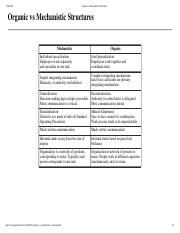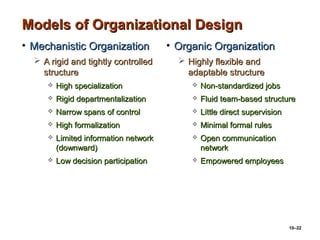Mechanistic structure and organic structure are two different approaches to organizing a business or other organization. Mechanistic structure is characterized by a high degree of standardization, specialization, and hierarchical control. It is typically associated with large, bureaucratic organizations that operate in stable environments. On the other hand, organic structure is characterized by flexibility, adaptability, and decentralized decision-making. It is typically associated with small, entrepreneurial organizations that operate in dynamic environments.
Mechanistic structure is based on the idea that an organization can achieve efficiency and predictability by breaking down tasks into smaller, specialized units and creating clear lines of authority and control. This approach is best suited for organizations that face stable environments and can rely on established procedures and routines to achieve their goals. In a mechanistic organization, employees are typically assigned to specific roles and are expected to follow established rules and procedures. Decision-making is centralized and hierarchical, with decisions flowing from top to bottom through the organizational hierarchy.
Organic structure, on the other hand, is based on the idea that an organization can achieve adaptability and flexibility by decentralizing decision-making and encouraging collaboration and communication across organizational boundaries. This approach is best suited for organizations that face dynamic environments and need to be able to adapt to changing circumstances. In an organic organization, employees are given more autonomy and are expected to work collaboratively to achieve common goals. Decision-making is decentralized, with employees at all levels of the organization involved in the process.
There are advantages and disadvantages to both mechanistic and organic structure. Mechanistic structure can lead to efficiency and predictability, but it can also be inflexible and resistant to change. Organic structure can be more adaptable and responsive to change, but it can also be less efficient and more prone to conflicting interests and conflicting agendas.
Ultimately, the choice between mechanistic and organic structure depends on the needs and goals of the organization. Some organizations may find that a mechanistic structure is the best fit, while others may prefer an organic structure. It is important for organizations to carefully consider their goals and the nature of their environments when deciding which approach to use.
6 Difference Between Mechanistic & Organic Structure

An organic structure provides the flexibility for this strategy. It is a management system based on formality and authority, carefully outlining what is to be done by an individual. Tywin is at the top of the pyramid of authority, supported by vice presidents responsible for functional areas such as marketing and finance. On the basis of the literature, eight dimensions, corresponding to the parameters technical system, formalization, centralization, structural complexity, planning and control systems, training, information flows, and culture, form this construct. The unbiased approach predictably leads to optimal efficiency. He is supported by ministers who head national functional areas ministries like internal security and foreign affairs. Mechanistic Organizational Structure Definition A centralized authority and specialized roles characterize a mechanistic organizational structure.
Organic vs Mechanistic Organizational Structure

What is a professional bureaucracy structure? Though the structure has produced excellent results so far, the centralized d. Mechanistic Organizations Mechanistic organizations have centralized decision making and formal, standardized control systems. People work in different capacities simultaneously and over time What is a mechanistic organizational structure? But when a mountain guide complained that his Gore-Tex parka was leaking while he is hiking in the mountains, the company realized the failure of the initial solution they offered and quickly recalled and bought back all their Gore-Tex products. The system also values external knowledge and has a reduced hierarchy characterized by equal employee levels and no job descriptions. Mechanistic Structure is appropriate for organizations focusing on a cost- minimization strategy through tight control, extensive division of labor, high formalization and centralization. Dynamic environments, differentiation of tasks and little standardization are the concepts of the organic system. Businesses with an organic structure often encourage group participation and the sharing of work responsibilities.
Mechanistic Versus Organic Structures

According to these theorists, organic organizations are flexible and have the least specialization of functions. Differences in Organizational Characteristics Communication within a bureaucratic structure is formal and commonly relies on written messages, reports and memos. The structure that would be most appropriate for an innovative organization like Apple or 3M would be organic structure. In general, the more stable the environment, the more mechanistic the organization. The professional bureaucracy is a highly decentralized structure, in both the vertical and horizontal dimensions. In the decentralized control the organization design are flat structures and has shared influence.
Mechanistic Vs. Organic Organizational Structure

The main lining… Biotechnology Industry Analysis This report will analysis the industry characteristics via value the chain, use Porter's five forces,and compare with the market. This gives a sense of belonging to those who are a part of any organization utilising these principles. Mechanistic organisation structure expects subordinates to obey and be loyal to superiors and the organisation. Mechanistic structures believe upper management is capable of the decision making process, management instructions must be followed, communication and control must follow hierarchal routes and that tasks should be standardized and formalized. Mechanistic organization structure is a very rigid and efficient form of organization. Creativity, forward thinking and change is not needed within organisations that have this type of structure.









